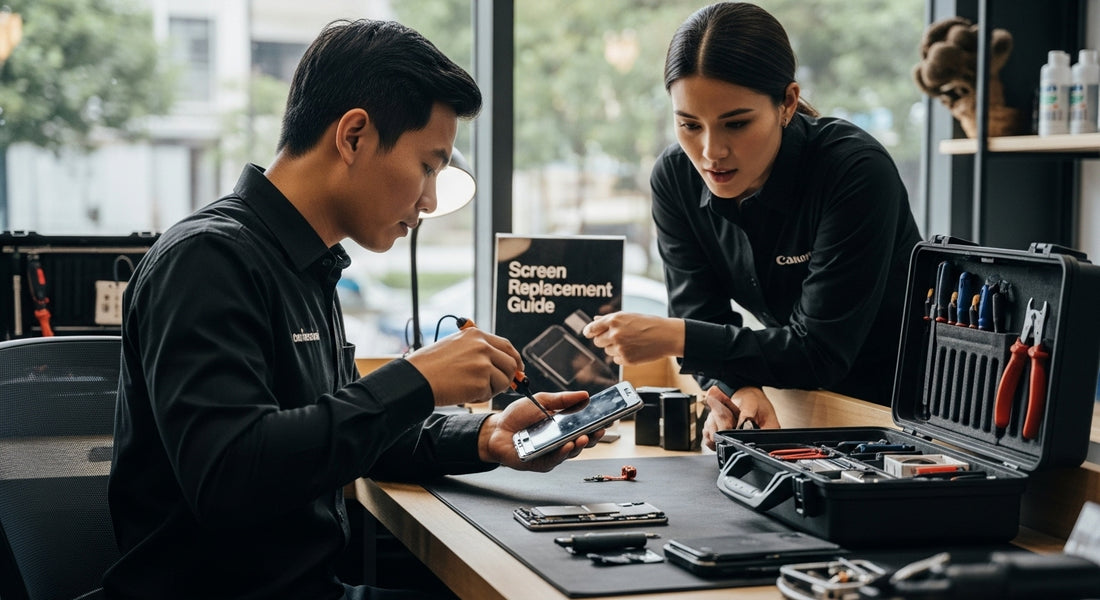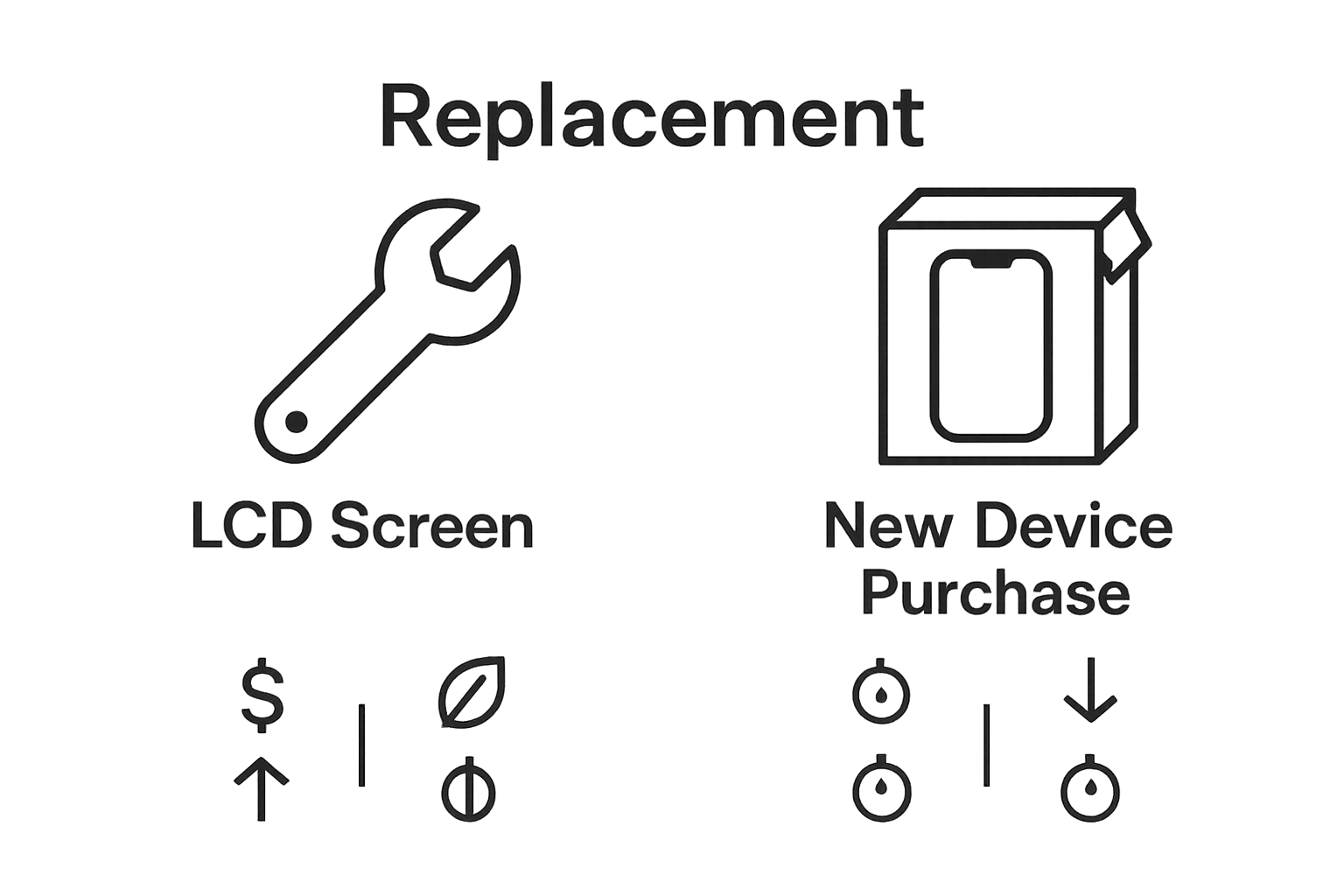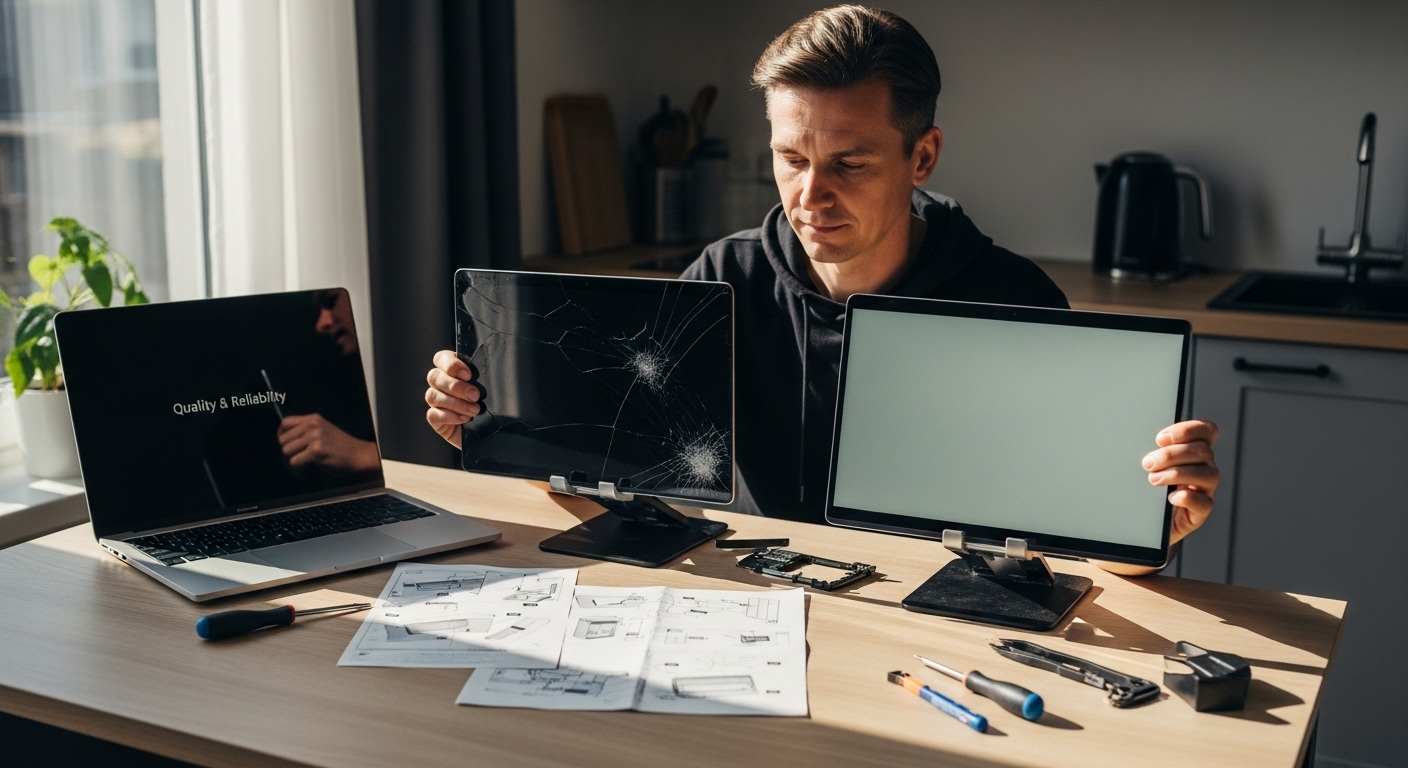
Understanding LCD Screen Replacement Guide for Electronics
Share
LCD screens are everywhere. Nearly every smartphone, tablet, and monitor in your home relies on them for sharp visuals and brilliant colour. It sounds simple and standard until you realise that over 80 percent of electronic devices globally now use LCD technology as their main display. But keeping these screens in top condition is a different story entirely. There is far more to replacement and reliability than you might expect.
Table of Contents
- What Is An Lcd Screen And Its Role In Devices?
- Why Lcd Screen Replacement Matters For Longevity And Usability?
- How Lcd Technology Works And Its Components Explained?
- Key Considerations When Choosing Replacement Screens
- Understanding Quality And Reliability In Replacement Parts
Quick Summary
| Takeaway | Explanation |
|---|---|
| LCD screens enhance device visuals efficiently | LCD technology offers high-resolution graphics while consuming less power compared to older display technologies. |
| Timely screen replacement extends device lifespan | Replacing a damaged LCD promptly can renew functionality and prevent further device failures. |
| Screen compatibility is critical for performance | Ensure replacement screens match exact specifications to guarantee proper function and avoid performance issues. |
| Quality of replacement parts matters significantly | Investing in high-quality components ensures long-term reliability and performance of your device. |
| Sustainable practices emerge from screen replacement | Replacing screens reduces electronic waste and encourages responsible electronics consumption, benefiting the environment. |
What is an LCD Screen and Its Role in Devices?
Liquid Crystal Display (LCD) screens represent a critical technological innovation in visual display technologies, transforming how electronic devices communicate visual information. LCD screens serve as fundamental output components across numerous electronic platforms, delivering high-resolution graphics and text with remarkable energy efficiency.
Understanding LCD Screen Technology
At its core, an LCD screen operates through an intricate mechanism involving liquid crystals suspended between two polarised glass panels. These liquid crystals function as light valves, manipulating light transmission to create visual images. When electrical currents pass through specific crystal molecules, they align in precise configurations, allowing or blocking light passage, which ultimately generates the pixels visible on screen.
The fundamental architecture of LCD screens involves several critical components:
- Liquid Crystal Layer: The primary element responsible for image generation
- Polarising Filters: Control light orientation and transmission
- Backlight: Provides illumination behind the crystal layer
- Colour Filters: Enable colour representation across the display
Applications Across Electronic Ecosystems
LCD technology has revolutionised visual interfaces in multiple domains. Smartphones, tablets, computer monitors, televisions, automotive displays, and medical equipment rely extensively on LCD screens. Research from Display Technology Institute demonstrates that LCD screens offer superior performance characteristics compared to predecessor technologies, including:
- Significantly lower power consumption
- Enhanced colour reproduction
- Reduced physical footprint
- Improved durability and longevity
The versatility of LCD screens stems from their ability to provide crisp, clear visuals while maintaining compact design requirements. Whether rendering complex graphical interfaces or displaying critical medical diagnostics, LCD technology continues to be a cornerstone of modern electronic visual communication, bridging complex technological processes with user-friendly visual experiences.
Below is a table summarising the core components of LCD screen technology and their specific roles in display function.
| Component | Description |
|---|---|
| Liquid Crystal Layer | Manipulates light to generate the visible image |
| Polarising Filters | Set the orientation and transmission of light |
| Backlight | Illuminates the liquid crystal layer from behind |
| Colour Filters | Provide colour representation for each pixel |
| Thin Film Transistors (TFTs) | Manage electrical signals for individual pixels |
Why LCD Screen Replacement Matters for Longevity and Usability?
LCD screen replacement represents a critical intervention in maintaining electronic device functionality and performance. Research from Consumer Electronics Repair Association indicates that timely screen replacement can significantly extend a device’s operational lifespan, preventing complete device failure and reducing overall electronic waste.
Economic and Environmental Implications
Replacing a damaged LCD screen offers substantial economic advantages compared to purchasing an entirely new device. Damaged screens can compromise device usability, reducing performance and creating potential safety risks.
 Screen damage often occurs through accidental impacts, pressure points, or gradual wear, making replacement a strategic decision for device owners.
Screen damage often occurs through accidental impacts, pressure points, or gradual wear, making replacement a strategic decision for device owners.
Key economic considerations for LCD screen replacement include:
- Substantially lower cost compared to full device replacement
- Preservation of existing device data and personalised configurations
- Maintenance of device performance and functionality
- Reduction of electronic waste and environmental impact
Impact on Device Performance and User Experience
A compromised LCD screen directly impacts user interaction and device reliability. Cracks, dead pixels, colour distortions, and touch responsiveness issues can render devices nearly unusable. Electronic Repair Dynamics Report suggests that professional screen replacement restores device performance to near-original specifications, providing users with a cost-effective alternative to complete device replacement.
Potential performance improvements through screen replacement include:
- Restored visual clarity and colour accuracy
- Renewed touch sensitivity and responsiveness
- Elimination of visual distractions like pixel damage
- Prevention of further internal hardware damage
Beyond immediate functional benefits, LCD screen replacement contributes to sustainable electronics consumption. By extending device lifecycles, users can reduce electronic waste, conserve manufacturing resources, and minimise their environmental footprint. Professional screen replacement emerges as a smart, economical, and environmentally responsible approach to device maintenance.
The following table compares the economic and environmental implications of LCD screen replacement versus full device replacement to clarify their respective advantages.
| Factor | LCD Screen Replacement | Full Device Replacement |
|---|---|---|
| Cost | Significantly lower | Much higher |
| Data Preservation | Maintains existing device data and settings | Risk of loss unless data is transferred |
| Environmental Impact | Reduces electronic waste, eco-friendlier | Generates more waste, less sustainable |
| Performance Restoration | Restores to near-original specifications | New device, but higher resource use |
| Personalisation Retention | Preserves user’s personalised configurations | Requires reconfiguration |
How LCD Technology Works and Its Components Explained?
Liquid Crystal Display (LCD) technology represents a sophisticated visual rendering system that transforms electrical signals into visible imagery through an intricate molecular manipulation process. Liquid crystal display mechanisms operate on principles of light manipulation and precise electrical control, enabling remarkable visual reproduction across electronic devices.
Core Operational Principles
The fundamental mechanism of LCD technology revolves around liquid crystal molecules positioned between two polarised glass panels. These microscopic crystals function as dynamic light gates, changing their molecular orientation when electrical currents pass through them. This molecular realignment determines how light passes through, effectively creating pixels that generate visual representations.
The core operational components include:
- Liquid Crystal Layer: Primary light manipulation medium
- Polarising Filters: Control light wave orientation
- Thin Film Transistors (TFTs): Manage individual pixel electrical signals
- Colour Filters: Enable multi-colour display capabilities
Electrical Signal Transformation Process
Display Technology Research Centre explains that LCD screens convert electrical signals into visual output through a multi-stage process. When an electrical current activates specific crystal molecules, they rotate or align, modifying light transmission characteristics. This precise control allows for creating complex images by manipulating light passage through individual pixels.
The signal transformation involves several critical stages:
- Electrical signal received by thin film transistor grid
- Liquid crystal molecules rotate based on signal intensity
- Polarising filters modulate light transmission
- Colour filters generate multi-colour pixel representations
Understanding LCD technology reveals a remarkable intersection of molecular physics, electrical engineering, and optical manipulation. By transforming electrical signals into visible imagery through precisely controlled crystal movements, LCD screens continue to revolutionise visual communication across multiple electronic platforms.
Key Considerations When Choosing Replacement Screens
Selecting an appropriate LCD replacement screen requires comprehensive evaluation of multiple technical and compatibility factors. Electronic Repair Specialists Association emphasises that informed screen selection directly impacts device performance, longevity, and overall user experience.
Compatibility and Technical Specifications
Device model precision represents the most critical factor in screen replacement selection. Replacement screens must match exact specifications including connector type, resolution, display dimensions, and touch sensitivity capabilities. Variations in these parameters can render a screen non-functional or significantly compromise device performance.
Key technical compatibility considerations include:
- Precise device model number matching
- Identical connector pin configuration
- Matching screen resolution and aspect ratio
- Original manufacturer specifications compliance
- Touch sensitivity and digitiser alignment
Quality and Performance Factors
Display Technology Evaluation Institute highlights that screen quality extends beyond physical compatibility. Professional-grade replacement screens distinguish themselves through several critical performance metrics. Consumers must evaluate screens based on manufacturing standards, component quality, and potential long-term reliability.
Critical quality assessment parameters involve:
- Original equipment manufacturer (OEM) equivalent standards
- Colour accuracy and reproduction capabilities
- Durability and structural integrity
- Warranty and technical support provisions
- Potential performance degradation factors
Beyond technical specifications, screen replacement decisions require balanced consideration of cost, performance, and long-term device functionality. Selecting a high-quality replacement screen represents an investment in device preservation, ensuring continued usability and minimising future repair requirements. Careful research, professional consultation, and understanding individual device requirements form the foundation of successful LCD screen replacement strategies.
Understanding Quality and Reliability in Replacement Parts
Replacement LCD screen components represent a complex ecosystem of manufacturing standards, performance metrics, and technological precision. Electronic Components Reliability Association emphasises that understanding replacement part quality extends far beyond simple visual compatibility.
Manufacturing Standards and Quality Control
Quality assessment in replacement screens involves rigorous multi-dimensional evaluation, encompassing manufacturing processes, component sourcing, and performance consistency. Professional-grade replacement parts undergo extensive testing to ensure they meet or exceed original equipment manufacturer (OEM) specifications.
Key quality control parameters include:
- Precision manufacturing tolerances
- Material composition consistency
- Electrical signal integrity
- Thermal performance characteristics
- Structural durability under stress conditions
Performance and Longevity Metrics
Display Technology Performance Institute reveals that reliable replacement screens must demonstrate comprehensive performance capabilities beyond initial functionality. Sustained performance involves complex interactions between electrical, thermal, and mechanical systems.
Critical performance evaluation criteria encompass:
- Consistent colour reproduction stability
- Touch sensitivity precision
- Resistance to environmental degradation
- Signal processing reliability
- Long-term operational consistency
Understanding replacement part quality requires sophisticated technical knowledge and comprehensive evaluation. Consumers and technicians must look beyond surface-level compatibility, considering intricate performance metrics that determine long-term device functionality. Investing in high-quality replacement components represents a strategic approach to maintaining electronic device performance, reliability, and operational integrity.

Trusted LCD Screen Replacement Solutions for Long-Term Device Care
Struggling with a cracked or unresponsive LCD screen can be stressful. This article shows how even a small fault in your display can disrupt your daily routine, impact productivity and reduce the functional lifespan of your device. Whether you are worried about compatibility issues, preserving your data, or simply wish to avoid the high costs and environmental impact of replacing an entire device, you deserve a repair partner who understands the technical details and your need for reliability.
At Buy2fix we specialise in high-quality LCD replacement screens and repair parts for all major smartphone, tablet and laptop brands. With our extensive stock of both aftermarket and genuine components, every item is fully tested and backed by a one-year warranty. We support both DIY users and professional repairers, ensuring you benefit from expert guidance and competitive prices. Protect your device and your budget by sourcing your replacement parts from a retailer focused on quality and trust. Ready to restore your device and experience lasting performance? Visit Buy2fix LCD Screen Replacement Parts now to browse our complete range and enjoy free UK shipping, fast dispatch, and friendly customer support. Secure your device’s future today and say goodbye to screen problems for good.
Frequently Asked Questions
What are the common signs that my LCD screen needs replacement?
Common signs include visible cracks, dead pixels, colour distortions, and unresponsive touch sensitivity. These issues can severely hinder device usability and performance.
How does replacing an LCD screen impact my device’s performance?
Replacing an LCD screen can restore visual clarity, improve colour accuracy, and regain touch responsiveness, thus enhancing the overall user experience and extending device longevity.
What factors should I consider when selecting a replacement LCD screen?
Key factors include matching the exact device model, ensuring compatibility with connector types and resolution, and evaluating the quality of the replacement part based on manufacturer specifications and performance metrics.
Are third-party replacement LCD screens reliable compared to original equipment manufacturer (OEM) parts?
While some third-party replacement screens can offer similar performance and quality, it’s essential to thoroughly research the manufacturer’s standards, warranty provisions, and user reviews to ensure reliability and durability.
Recommended
- Cell Phone, Tablets & Laptops, Parts & Spares - Buy2Fix – buy2fix
- Front Screen Outer Glass Lens with OCA Optically Clear Adhesive for Xi – buy2fix
- Front Screen Outer Glass Lens with OCA Optically Clear Adhesive for Xi – buy2fix
- For OPPO A83 Front Screen Outer Glass Lens with OCA Optically Clear Ad – buy2fix
Share
Let customers speak for us
from 2140 reviewsPerfect fit, stylish and practical. The wallet attaches firmly and easily accommodates credit cards drivers licence etc.

Working well

Good fit

Very good quality and good fit for Dyson.

This is a genuine Safety Case Strap for DJI Matrice 4.
It arrived well packed.

Excellent fit and so compact even though it has many card slots and coin space, would definitely recommend

All OK

solved my issue here. Perfect, better than the orginal brand standard remote

Excellent website allowing for identification proper parts, good quality and timely delivery. Recommend.

Super hoesje👍👍👍👍👍

I'm very happy with my order, the quality is very good, I recommend:)

Absolutely amazing really best thing I’ve ever used

Nicely stitched quality leather throughout with an attractive checker-board patterned frontage. Shows no sign of wear or fading after considerable use. Good magnetic closure. The sturdy cover provides good protection without being bulky. I expect many years service from this product

Good 👍🏻 😊


